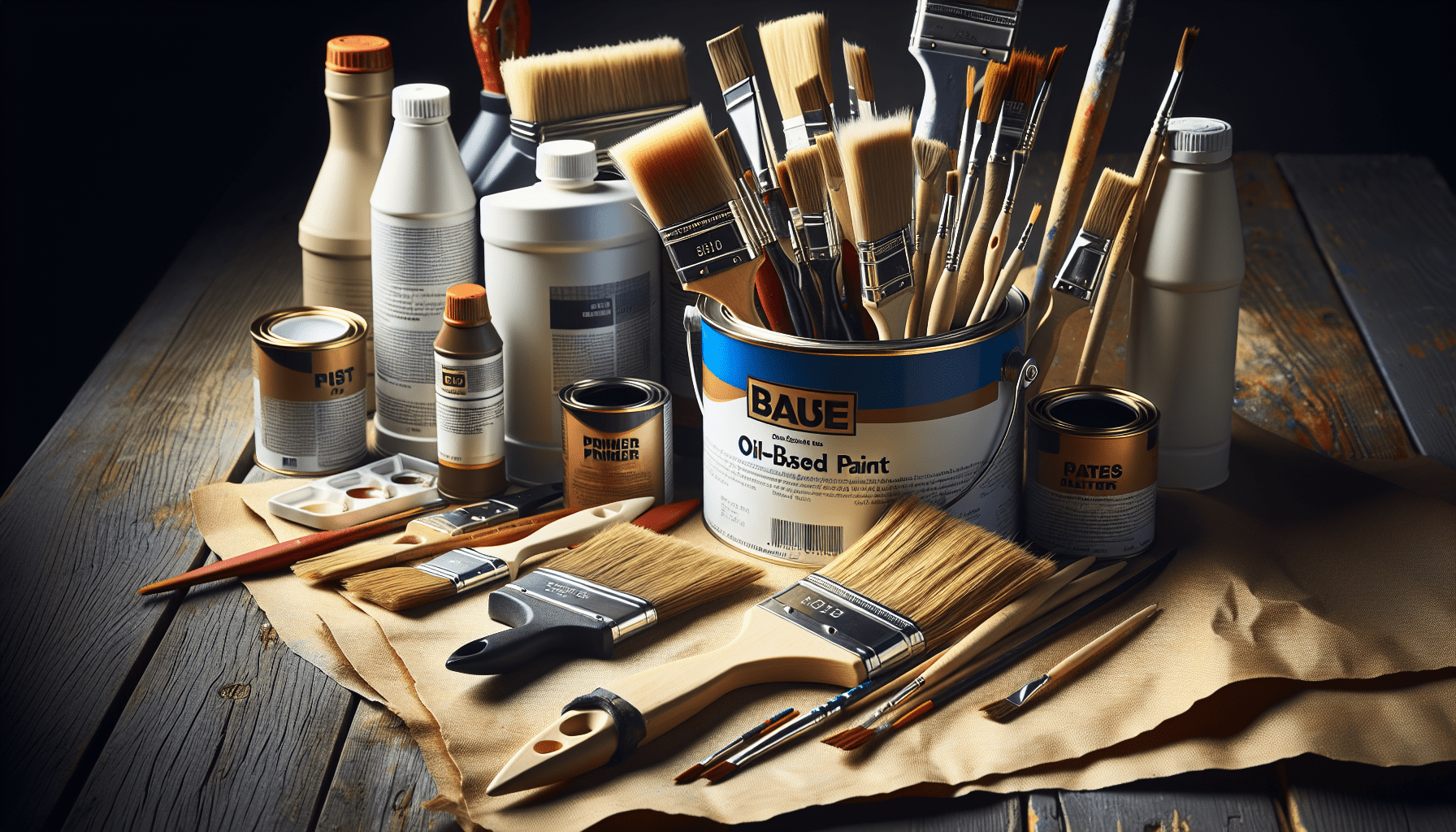In your endeavors to improve your living space, you may encounter the persistent and often unpleasant odor of oil-based paint. This article, “How To Get Rid Of Oil Based Paint Smell,” provides expert advice and practical methods for effectively eliminating these smells from your environment. By following the steps outlined, you will ensure a fresher, cleaner atmosphere, allowing you to enjoy the fruits of your labor without the lingering odors that can diminish your indoor air quality. The following guide will empower you with knowledge, from utilizing natural absorbents to implementing proper ventilation techniques, to restore and maintain a comfortable home. Have you recently painted a room with oil-based paint and found yourself overwhelmed by the lingering smell? The potent odor can be not only unpleasant but also harmful if inhaled for prolonged periods. Addressing this issue promptly and effectively is crucial for ensuring a safe and comfortable living environment. In this article, you will discover multiple strategies to get rid of the oil-based paint smell efficiently.
Understanding the Source of the Odor
Before delving into the remedies, it’s essential to comprehend why oil-based paint retains such a strong odor. Oil-based paints emit volatile organic compounds (VOCs) during the drying process. These VOCs are responsible for producing the sharp, often irritating smell that can last for days or even weeks.
What are VOCs?
VOCs, or volatile organic compounds, are chemicals that easily evaporate at room temperature, releasing gases into the air. Commonly found in oil-based paints, cleaning agents, and various household products, VOCs can have both short-term and long-term health effects, including headaches, dizziness, and respiratory problems.
Why is the Smell Stronger with Oil-Based Paints?
The smell of oil-based paints tends to be more pronounced because they contain higher levels of VOCs compared to water-based paints. The slower drying time of oil-based paints further exacerbates this issue, leading to prolonged odor release.
Preparation Before Painting
Proper preparation can significantly reduce the intensity and duration of the paint smell. Here are some preemptive steps you should take:
Choose Low-VOC Paints
Opting for low-VOC or zero-VOC oil-based paints whenever possible is a wise decision. These options emit fewer harmful chemicals, resulting in a less intense odor and healthier indoor air quality.
Ventilation is Key
Ensuring adequate ventilation is one of the most effective ways to minimize paint fumes. Open all windows and doors in the room you’re painting and use fans to circulate the air. Position the fans to blow air out of the room, facilitating the removal of VOCs.
Use Protective Gear
Always use protective gear, such as masks and gloves, while painting. This not only protects you from inhaling harmful fumes but also minimizes your direct contact with the chemicals.

Immediate Actions Post-Painting
Once the painting is done, immediate actions are necessary to expedite the odor removal process.
Keep the Room Ventilated
Continue to maintain good ventilation even after you’ve finished painting. Keep windows and doors open and use fans to ensure continuous airflow. Ventilation helps in dispersing the VOCs effectively.
Use Air Purifiers
Air purifiers can be a great ally in removing paint fumes. Choose an air purifier equipped with a HEPA filter and activated carbon. These models can trap VOCs efficiently, helping to improve air quality.
Dehumidifiers
Utilize dehumidifiers to reduce humidity levels. Lower humidity can speed up the drying process of oil-based paint, thereby reducing the duration of the smell.
Natural Odor Absorbers
Incorporating natural odor absorbers can make a substantial difference in eliminating the paint smell. Below are some tried and true methods:
Baking Soda
Baking soda is universally known for its odor-absorbing properties. Place bowls of baking soda around the painted area to neutralize the odor.
Charcoal
Activated charcoal is another excellent odor absorber. Like baking soda, it can trap VOCs and help to purify the air. Place it in different corners of the room for optimal results.
Vinegar
White vinegar can neutralize strong odors. Place bowls of vinegar around the painted room, or even use it in a spray form to target specific areas.
| Natural Absorber | Method of Use |
|---|---|
| Baking Soda | Bowls placed around the room |
| Charcoal | Activated charcoal in different corners |
| Vinegar | Bowls placed around the room or in a spray form |

Advanced Techniques
For those who prefer a more robust approach, here are some advanced techniques that can substantially reduce or eliminate the paint smell.
Commercial Odor Neutralizers
Many commercial odor neutralizers are specifically designed to tackle paint fumes. Products containing activated charcoal or other odor-absorbing chemicals can be particularly effective.
DIY Scent Fillers
Create homemade scent fillers by mixing water, essential oils, and a small amount of vinegar in a spray bottle. Use this mixture to lightly mist the air and surfaces around the painted area. Essential oils like lavender, eucalyptus, and peppermint are not only pleasant but also have natural odor-fighting properties.
Ozone Generators
Ozone generators can be highly effective in eliminating paint odors. These devices produce ozone, which can neutralize VOCs. However, it’s crucial to use ozone generators correctly, as high concentrations of ozone can be harmful. Use them in unoccupied rooms and air out the room thoroughly before re-entering.
Long-Term Preventative Measures
Even after successfully getting rid of the paint smell, adopting long-term preventative measures can be highly beneficial.
Regular Ventilation
Make it a habit to regularly ventilate your living spaces, especially when using products that emit VOCs. Good ventilation helps to dilute indoor air pollutants and maintain a healthier indoor environment.
Houseplants
Certain houseplants are effective in absorbing VOCs and improving indoor air quality. Plants such as spider plants, Boston ferns, and English ivy can naturally filter the air and are a great addition to any room.
| Plant Type | VOCs Absorbed |
|---|---|
| Spider Plant | Formaldehyde, Xylene |
| Boston Fern | Formaldehyde |
| English Ivy | Benzene, Formaldehyde |
Regular Cleaning
Regular cleaning helps in reducing the accumulation of VOCs. Use low-VOC cleaning products and ensure that household fabrics like curtains and carpets are cleaned periodically, as they can trap VOCs.
Common Mistakes to Avoid
While trying to eliminate the oil-based paint smell, some common mistakes can hamper your efforts.
Ignoring Ventilation
One of the biggest mistakes you can make is underestimating the importance of ventilation. Without proper airflow, VOCs will continue to linger, making it difficult to get rid of the smell.
Using Harsh Chemicals
Using harsh chemicals to mask the smell can sometimes worsen the situation. These products might add more VOCs to the air, complicating the problem further. Always opt for natural or specially designed odor absorbers.
Overlooking Safety Precautions
Neglecting personal protective gear during the painting and deodorizing process can expose you to harmful chemicals. Always prioritize safety by using masks, gloves, and ensuring you’re working in a well-ventilated area.
When to Seek Professional Help
Despite your best efforts, there might be cases where the paint smell persists. In such scenarios, seeking professional help can be a practical solution.
Persistent Odor
If the odor persists for more than a few weeks despite using various remedies, it might be best to consult professionals who can conduct a thorough assessment and provide specialized odor removal services.
Health Implications
Prolonged exposure to VOCs can lead to health issues such as headaches, dizziness, and respiratory problems. If you or someone in your household is experiencing these symptoms, consult a healthcare professional and consider getting professional air quality testing.
Conclusion
Getting rid of the oil-based paint smell is achievable by understanding the underlying causes and implementing a combination of immediate actions, natural odor absorbers, and advanced techniques. Proper preparation before painting, maintaining good ventilation, and regular cleaning can go a long way in minimizing the impact of VOCs. By following these strategies, you’ll ensure a safer and more pleasant living environment. If all else fails, don’t hesitate to seek professional help to address any persistent issues. Your well-being and comfort are paramount, and taking these steps will make your freshly painted space a much more enjoyable place to live.



